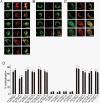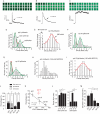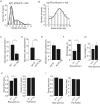Release mode of large and small dense-core vesicles specified by different synaptotagmin isoforms in PC12 cells
- PMID: 21551071
- PMCID: PMC3128534
- DOI: 10.1091/mbc.E11-02-0159
Release mode of large and small dense-core vesicles specified by different synaptotagmin isoforms in PC12 cells
Abstract
Many cells release multiple substances in different proportions according to the specific character of a stimulus. PC12 cells, a model neuroendocrine cell line, express multiple isoforms of the exocytotic Ca(2+) sensor synaptotagmin. We show that these isoforms sort to populations of dense-core vesicles that differ in size. These synaptotagmins differ in their Ca(2+) sensitivities, their preference for full fusion or kiss-and-run, and their sensitivity to inhibition by synaptotagmin IV. In PC12 cells, vesicles that harbor these different synaptotagmin isoforms can be preferentially triggered to fuse by different forms of stimulation. The mode of fusion is specified by the synaptotagmin isoform activated, and because kiss-and-run exocytosis can filter small molecules through a size-limiting fusion pore, the activation of isoforms that favor kiss-and-run will select smaller molecules over larger molecules packaged in the same vesicle. Thus synaptotagmin isoforms can provide multiple levels of control in the release of different molecules from the same cell.
Figures







Similar articles
-
Synaptotagmin modulation of fusion pore kinetics in regulated exocytosis of dense-core vesicles.Science. 2001 Nov 2;294(5544):1111-5. doi: 10.1126/science.1064002. Science. 2001. PMID: 11691996
-
Allosteric stabilization of calcium and phosphoinositide dual binding engages several synaptotagmins in fast exocytosis.Elife. 2022 Aug 5;11:e74810. doi: 10.7554/eLife.74810. Elife. 2022. PMID: 35929728 Free PMC article.
-
Synaptotagmin function in dense core vesicle exocytosis studied in cracked PC12 cells.Nat Neurosci. 2002 Jul;5(7):649-56. doi: 10.1038/nn869. Nat Neurosci. 2002. PMID: 12055633
-
The diversity of synaptotagmin isoforms.Curr Opin Neurobiol. 2020 Aug;63:198-209. doi: 10.1016/j.conb.2020.04.006. Epub 2020 Jul 11. Curr Opin Neurobiol. 2020. PMID: 32663762 Review.
-
Synaptotagmin IV acts as a multi-functional regulator of Ca2+-dependent exocytosis.Neurochem Res. 2011 Jul;36(7):1222-7. doi: 10.1007/s11064-010-0352-7. Epub 2010 Dec 10. Neurochem Res. 2011. PMID: 21153436 Review.
Cited by
-
Amyloid-β Impairs Vesicular Secretion in Neuronal and Astrocyte Peptidergic Transmission.Front Mol Neurosci. 2017 Jun 28;10:202. doi: 10.3389/fnmol.2017.00202. eCollection 2017. Front Mol Neurosci. 2017. PMID: 28701919 Free PMC article.
-
REST-Governed Gene Expression Profiling in a Neuronal Cell Model Reveals Novel Direct and Indirect Processes of Repression and Up-Regulation.Front Cell Neurosci. 2015 Nov 10;9:438. doi: 10.3389/fncel.2015.00438. eCollection 2015. Front Cell Neurosci. 2015. PMID: 26617488 Free PMC article.
-
Presynaptic inhibition of the release of multiple major central nervous system neurotransmitter types by the inhaled anaesthetic isoflurane.Br J Anaesth. 2013 Apr;110(4):592-9. doi: 10.1093/bja/aes448. Epub 2012 Dec 4. Br J Anaesth. 2013. PMID: 23213036 Free PMC article.
-
Synaptotagmin-7 places dense-core vesicles at the cell membrane to promote Munc13-2- and Ca2+-dependent priming.Elife. 2021 Mar 22;10:e64527. doi: 10.7554/eLife.64527. Elife. 2021. PMID: 33749593 Free PMC article.
-
Real-time imaging of plasma membrane deformations reveals pre-fusion membrane curvature changes and a role for dynamin in the regulation of fusion pore expansion.J Neurochem. 2012 Aug;122(4):661-71. doi: 10.1111/j.1471-4159.2012.07816.x. Epub 2012 Jun 27. J Neurochem. 2012. PMID: 22671293 Free PMC article. Review.
References
-
- Alvarez de Toledo G, Fernandez-Chacon R, Fernandez JM. Release of secretory products during transient vesicle fusion. Nature. 1993;363:554–558. - PubMed
-
- Ariga T, Macala LJ, Saito M, Margolis RK, Greene LA, Margolis RU, Yu RK. Lipid composition of PC12 pheochromocytoma cells: characterization of globoside as a major neutral glycolipid. Biochemistry. 1988;27:52–58. - PubMed
-
- Augustine GJ. How does calcium trigger neurotransmitter release? Curr Opin Neurobiol. 2001;11:320–326. - PubMed
Publication types
MeSH terms
Substances
Grants and funding
LinkOut - more resources
Full Text Sources
Molecular Biology Databases
Miscellaneous

